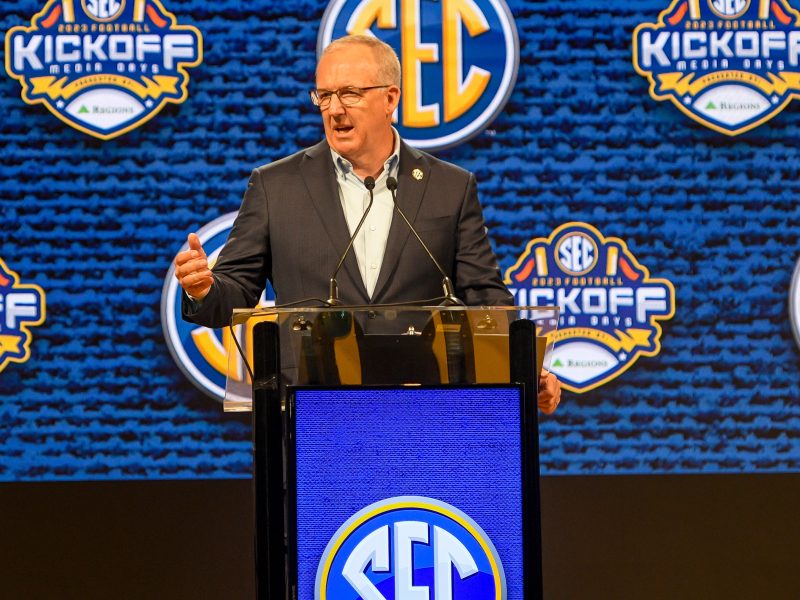SEC commissioner Greg Sankey was speaking on the Triple Option podcast earlier this week, and the future of college football was laid out for all to see.
If it wasn’t clear already, it will be now after the most powerful man in college sports pulled back the curtain.
The SEC and Big Ten are in the process of taking their ball home — and making billions with it.
“They want to be us, and that’s on them to figure it out,” Sankey said. “Not on me to bring myself back to Earth.”
How about that for the NCAA’s long-held mantra of collegial cooperation of like minds?
Understand this: Sankey says nothing without intent. He’s measured and detailed, and there’s purpose to everything.
So it should come as no surprise that this latest revelation comes a week before SEC and Big Ten officials meet again to discuss the future of their place in the sport. Together.
They’ll deal next week with the fallout of the House case awarding billions to former players, moving forward with millions in revenue sharing (see: pay for play) possibly as soon as the 2025 season, and finding new streams of revenue through non-conference scheduling to help pay for it.
Sankey’s comments also came shortly after something called the College Student Football League was officially unveiled as an option to “grow FBS college football and adapt to a legal and political landscape.”
WEEKEND FORECAST: Expert picks for every Top 25 game in Week 6
AWARD TIME: The highs and lows of college football’s first month
A 136-team “league” that has 72 teams in its top division (essentially, the current 68 Power conference teams and Notre Dame), and the remaining 64 in another — with the concept of regulation and promotion movement between divisions.
This, of course, has about as much of a chance to succeed as the XFL.
Because the idea of such a league is based on the SEC and Big Ten coming back to the pack, their 34 universities choosing to share the wealth with all involved out of the goodness of their hearts.
So when Sankey was asked on the Triple Option podcast about being the “commissioner of college football” — this nebulous idea of a management of one directing the most dysfunctional and unwieldily association in the history of associations — he balked.
Then threw high and tight on the College Student XFL.
“I’ve studied it a little bit, and I come back to I don’t want to dumb down the Southeastern Conference to be part of some super league notion with 70 teams that some people speculate would happen,” Sankey said.
Hello, reality.
Look, in a Pollyanna world, college football finds a way for all to be fat and happy, strolling hand in hand down the yellow brick road. That’s not how this is going to play out.
Television consumers of football want big games and big moments and big stories. Advertisers who pay the bills want the same.
They want Georgia vs. Alabama and Ohio State vs. Oregon and Michigan vs. Texas. They don’t want Alabama vs. Western Kentucky or Ohio State vs. Marshall.
We’re five weeks into the season, and of the top 12 games in television ratings, the SEC has a team playing in 10. Four of the top 12 are SEC vs. SEC games.
All of the top 12 games have at least one SEC or Big Ten team involved. The final breakdown of conferences in the top 12: 10 SEC, three Big Ten, two ACC, one Big 12 and one Notre Dame.
And you want Sankey to go to his 16 university presidents, currently hemorrhaging cash from the House case, future revenue sharing and the facilities boom, and offer up the fiscally reckless idea of everyone eats in the College Student whatever it’s called?
The SEC and Big Ten aren’t necessarily breaking away from the rest of college football as much as they are moving forward. Because a clean break comes with legal hurdles and public scorn.
So Sankey and Big Ten commissioner Tony Petitti have painted this canvas as a “working group” to deal with “challenges” facing college sports. It’s brilliant in its simplicity.
Moving forward and creating natural separation from the rest of the pack by creating a favorable College Football Playoff format, and a scheduling monopoly with non-conference games that increase media rights revenue — and essentially boxes out the remainder of the field.
And who among us will argue with more Michigan vs. LSU, and Ohio State vs. Alabama, and Georgia vs. Penn State in the regular season? To say nothing of similar games in the CFP.
This thing has surged like a rocket since the SEC announced expansion to 16 teams and the Big Ten moved to 18.
It’s not coming back to Earth any time soon.






